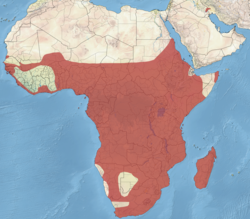| African darter | |
|---|---|
 | |
| in Botswana | |
| Scientific classification | |
| Kingdom: | Animalia |
| Phylum: | Chordata |
| Class: | Aves |
| Order: | Suliformes |
| Family: | Anhingidae |
| Genus: | Anhinga |
| Species: | A. rufa |
| Binomial name | |
| Anhinga rufa (Daudin, 1802) | |
 | |
| resident range | |
| Synonyms | |
Anhinga africana | |
The African darter (Anhinga rufa), sometimes called the snakebird, is a water bird of sub-Saharan Africa and Iraq. [1]





